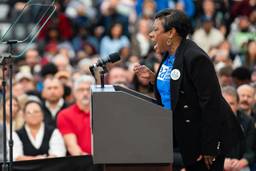
Congress is nearing a vote on arguably the biggest change to private pension law in decades.
The proposed reforms would grant sweeping new authority to the trustees of some “deeply troubled” multi-employer pension plans to slash benefits promised to current retirees — something that’s illegal under existing law. A cornerstone of some collective bargaining agreements, multi-employer plans cover more than 10 million workers, mostly in construction but also in the transportation, manufacturing, retail and service sectors.
Reps. John Kline (R-Minnesota) and George Miller (D-California), the highest-ranking members on the House Education and Workforce Committee, have brokered a last-minute deal to reform multi-employer pensions, In These Times has learned. They’re now urging party leaders to include the plan as part of an omnibus spending bill, just before the 113th Congress is set to leave Washington for good on December 11.
The full extent of the Kline-Miller proposal remains unclear. In addition to providing trustees with new benefit-gutting powers, it may include other less high-profile elements from the “Solutions Not Bailouts” report, a proposal authored last year by the National Coordinating Committee for Multiemployer Plans (NCCMP), a labor-management coalition.
Over the last year, proponents of the NCCMP plan have tried — and failed — to get a vote on a stand-alone bill. Seeking bipartisan support, they were stymied by the resignation of a key ally in Rep. Rob Andrews (D-New Jersey), the former ranking member on the pension subcommittee, and by mounting outcry from organized labor. After In These Times first reported on the plan last October, the Teamsters and Boilermakers joined the Machinists in opposition. (Meanwhile, Andrews, who faced a House ethics investigation when he stepped down in February, has since lobbied Congress on behalf of the NCCMP.)
Some unions welcome the reforms as a tough but necessary move to shore up the long-term solvency of the multi-employer pension system. The AFL-CIO’s Building and Construction Trades Department (BCTD) has lobbied most aggressively in support of the NCCMP plan, according to opponents of the proposal. A spokesperson for the BCTD did not respond to request for comment.
Multi-employer pension plans, all of which are partially insured by the federal Pension Benefit Guaranty Corporation (PBGC), do face a budget squeeze. All in all, the plans carry an $8.3 billion deficit that is projected to hit nearly $49.6 billion by 2023—the result of the economic crisis, a shortage of workers paying into the plans, and in some cases, mismanagement. If a multi-employer plan is unable to meet its obligations, the PBGC steps in and covers a small amount of what retirees are owed, but it’s a fraction of the the promised benefit.
Under the Kline-Miller plan, cuts would be restricted to 110 percent of benefits that the PBGC would otherwise pay. Congress must act now, the logic goes, or it’s going to hurt even more later.
The proposal includes another provision to soften the blow: Benefit cuts would need to be approved by retiree vote, unless the plan poses a “systemic risk” to the PBGC, in which case trustees can proceed without a vote.
But that sounds more comforting than it is. By far, the plan most at risk to the PBGC is the 410,000 member Teamsters’ Central States Fund. It’s highly unlikely the plan’s retirees would get a chance to vote on any benefit cuts.
Critics charge that it is unfair to place the burden of stabilizing the plans on the backs of retirees. After all, pension benefits are essentially deferred wages that have already been earned. They want trustees and Congress to consider other steps — plan mergers or bailouts, for instance — before messing with long-established “anti-cutback” rules. They’re also frustrated by the lack of transparency.
“For the NCCMP or any member of Congress to try to sneak this onto an end-year bill is outrageous,” says Karen Friedman, policy director at the Pension Rights Center, which strongly opposes the plan. “It’s nefarious, because they’re basically trying to sneak through provisions that would have a huge impact on millions of retirees, potentially set a dangerous precedent and torpedo a fundamental part of private pension law. And they’re trying to do all this in the last few weeks as Congress is getting ready to leave before the new Congress starts? That’s ridiculous. They should be ashamed of themselves.”
Rep. George Miller’s blessing is pivotal. After 39 years in Congress, the liberal stalwart is retiring at the end of the session.
“The Republicans could have moved this a year ago,” says Bruce Olsson, assistant director of legislative and political action for the Machinists. “They had the votes, but they didn’t want to jump off that bridge without holding hands with the Dems. You can already see the ads — ‘[Rep] so and so voted to cut the pensions of the elderly.’”
Miller’s support may swing Democrats who would normally be uneasy backing such major reforms.
“Miller is like this liberal lion. He’s done a lot of good stuff in his career over the years,” Olsson continues. “[He] gives cover to a lot of people who aren’t familiar with the issue” to support the proposal.
Union backers of the NCCMP proposal like the Building Trades have calculated that it is better to get a deal done now rather than later. They fear the next Congress will be even more heavy-handed in its approach, according to a lobbyist close to the issue. Republican majorities in the House and Senate, for instance, could move to strip union influence over multi-employer plans altogether.
But Kelley Stillwell, 57, a retired construction worker from Henderson, Nevada, and longtime member of Laborers Local 872, isn’t buying it. He is furious at his union’s leadership which, he says, ignores the plight of retirees.
“I joined the union movement 38 years ago and I retired with a pension guaranteed for the rest of my life,” says Stillwell. “I feel like this is a total sellout of the principles of the entire union movement.”
The International Association of Machinists (IAM) is a sponsor of In These Times. Sponsors have no role in editorial content.








